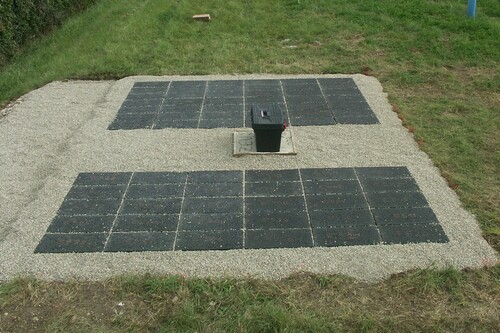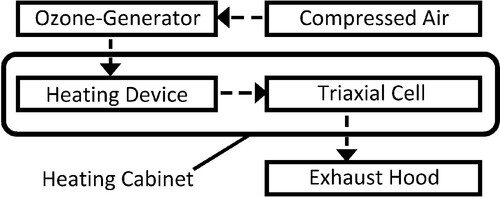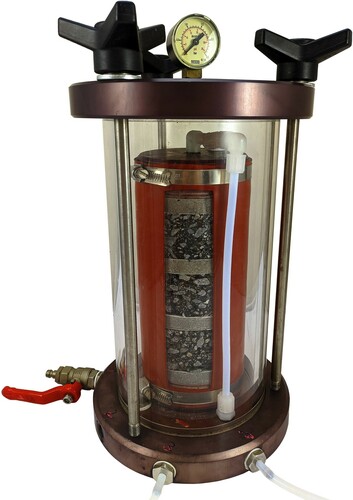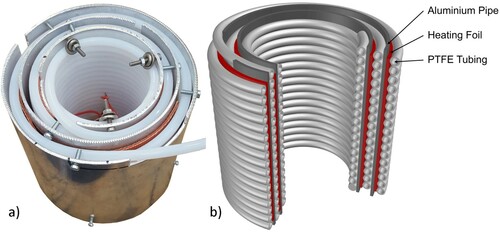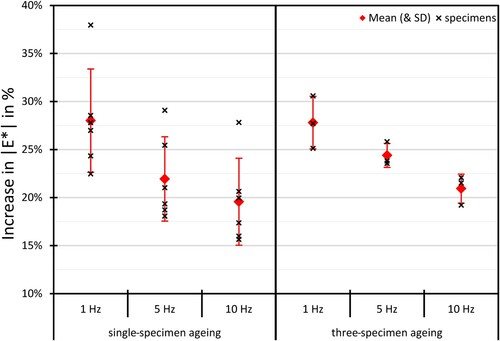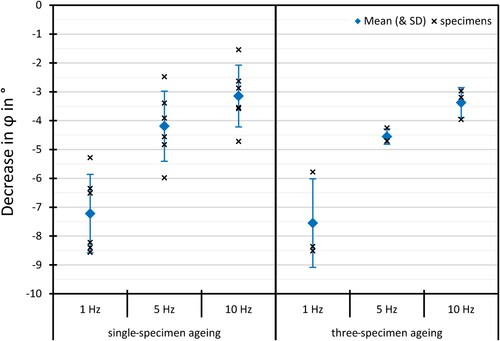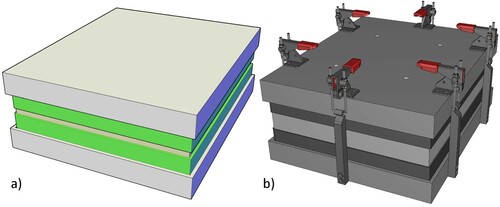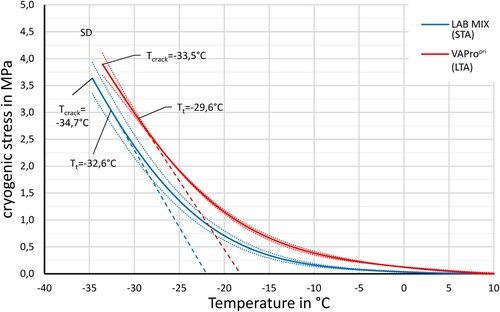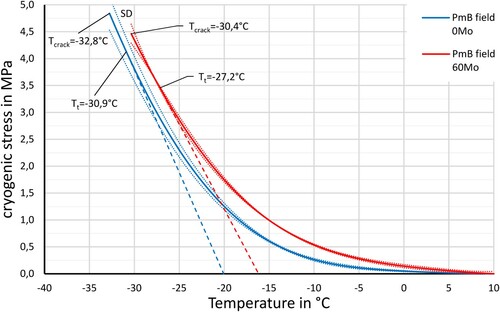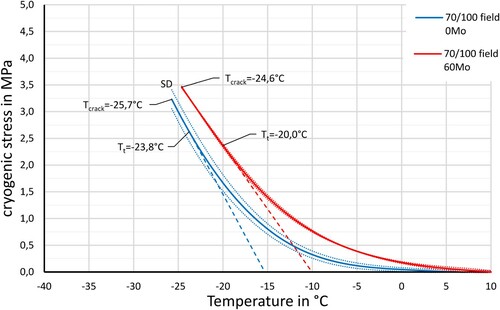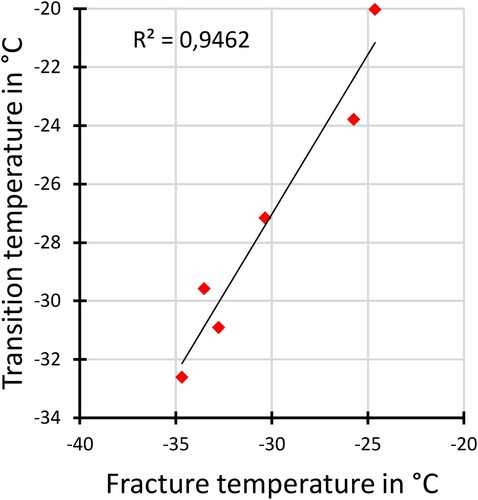 ?Mathematical formulae have been encoded as MathML and are displayed in this HTML version using MathJax in order to improve their display. Uncheck the box to turn MathJax off. This feature requires Javascript. Click on a formula to zoom.
?Mathematical formulae have been encoded as MathML and are displayed in this HTML version using MathJax in order to improve their display. Uncheck the box to turn MathJax off. This feature requires Javascript. Click on a formula to zoom.Abstract
As for all organic material, bitumen is prone to ageing under atmospheric conditions. This ageing process changes the properties of materials as it becomes stiffer and more brittle over time. This leads to a deterioration of low-temperature and fatigue performance and limits the life span of road pavements. On asphalt mix scale, various ageing methods have been developed in the past decades. A lately developed method, Viennese Ageing Procedure (VAPro), conditions specimens using a gas mixture containing traces of reactive oxygen species (ROS). This paper presents improvements of the initial device and the development of a new cell for ageing prismatic specimens for low-temperature testing. Cooling tests were conducted to the show proof of principle of the new ageing cell in comparison to field-aged samples. With the VAPro method at hand, asphalt mixtures can be optimised in terms of their long-term performance including relevant impacts of ageing on the performance.
Introduction
The change in material behaviour of bitumen over time is due to oxidation of the organic material. Natural and anthropogenic impacts increase stiffness and brittleness, which leads to deterioration in the performance properties of asphalt pavements, especially, resulting in more likely low-temperature cracks and decreasing fatigue resistance (Hofko et al., Citation2014; Petersen, Citation2009).
Considering time, ageing of bituminous material can be divided into short-term ageing (STA) during production and paving and long-term ageing (LTA) during its service life on the road. Fast oxidation due to high temperatures and a high specific surface at mix production, as well as the vaporisation of remaining volatile components, characterises STA (Baek et al., Citation2012). Slow oxidation, particularly in the upper layers of the asphalt, by traces of reactive oxygen species (ROS) found in the atmosphere-like ozone or nitrogen oxides, causes LTA (Hofko et al., Citation2015; Morian et al., Citation2011). UV radiation also contributes to LTA. In addition, moisture amplifies the impact of UV ageing (Hagos et al., Citation2009; Jing et al., Citation2019; Wei et al., Citation2019).
For prediction of the long-term behaviour of asphalt mixtures, it is important to simulate ageing of the material in the laboratory in order to choose the most suitable bitumen source and to build long-lasting and, thus, more sustainable roads with reduced need for maintenance and increased potential for recycling. The standardised methods, Rolling Thin Film Oven Test (RTFOT) and Pressure Ageing Vessel (PAV), are commonly used for STA and LTA on bitumen scale (da Costa et al., Citation2010).
On asphalt mix scale, the STA state is reached after slab production. For LTA, many procedures were developed in the last decades. Most of these protocols use high temperatures (above +100°C) and/or high pressure, which do not occur in the field. Consequently, additional effects could be induced by these methods, such as evaporation of further volatile binder components or altered reaction mechanism and kinetics that are not triggered in the field.
In the past years, a procedure called Viennese Ageing Procedure (VAPro) has been developed for ageing simulation of compacted specimens in field-like conditions concerning temperature (+60°C), pressure (∼0.5 bar) and ageing medium (Steiner et al., Citation2016). To increase the oxidation rate and achieve a change in material behaviour within an acceptable time span, VAPro perfuses cylindrical specimens with a gas mixture containing reactive oxygen species (ROS) that are present in the atmosphere as well, just in lower concentrations (Hofko et al., Citation2015; Seinfeld & Pandis, Citation2016). OH-radicals, ozone (O3) and nitrogen oxides (NOx) play a core role in tropospheric chemistry. UV-light is the driving force in these photochemical reactions and keeps the tropospheric cycle running (Atkinson, Citation1990; Kley, Citation1997). Previous studies have shown the crucial impact of O3, but especially of NOx on asphalt mixture specimens in field-like conditions (Hofko et al., Citation2020). By applying a more realistic ageing medium, VAPro aims to better assess behaviour of various antioxidants, rejuvenators etc. These additives might behave more realistically reacting with the ROS than just being exposed to high pressure and high temperature.
The original design of VAPro conditions cylindrical specimens. Cyclic indirect tensile tests (CIT-CY) can be conducted to gain information about change in visco-elastic properties or fatigue behaviour due to ageing. To investigate the low-temperature performance of asphalt mixes with the Thermal Stress Restrained Specimen Test (TSRST) prismatic specimens are required. With TSRST, various parameters can be obtained to describe the low-temperature performance of asphalt mixtures: These are fracture temperature, fracture strength, transition temperature from visco-elastic to elastic behaviour and the slope of the linear part of the temperature–stress curve (Yiqiu et al., Citation2012). At the beginning of the cooling test, a slow increase in thermal stress due to the relaxation capability of the material can be observed. By reaching the transition temperature, stresses are no longer relaxed and the stress–temperature curve shows a linear relationship until cracking of the specimen. Ageing reduces resistance to low-temperature cracking. Mixture design and air void content have a big impact on low-temperature properties (Isacsson & Zeng, Citation1998; Lin et al., Citation2017; Lu & Isacsson, Citation1998).
This paper shows improvements of the initial setup as well as the development of a new cell for ageing prismatic specimens. First, TSRST results of aged specimens show the proof of principle by comparing with 5-year-old field samples. With this method at hand, the long-term performance of asphalt mixes can be taken into account in mix design and optimisation with regard to realistic ageing mechanisms.
Materials and methods
Materials
This study combines results from individual test programs and test sections in the field. Therefore, several different materials are used. It is noted in the results section, which mix comes to use in the specific comparisons.
For lab-produced specimens, an asphalt concrete (AC) according to EN 13108-1 (CEN, Citation2016b) and a stone mastic asphalt (SMA) according to EN 13108-5 (CEN, Citation2016c) with a maximum nominal grain size of 11 mm are produced. For both mixes, porphyrite is used as a coarse mineral aggregate and powdered limestone as filler. The mixes are produced at +160°C in a laboratory mixer and compacted in roller compactor according to EN 12697-35 (CEN, Citation2016a). A polymer-modified binder PmB 45/80-65 (Binder A) in accordance with EN 14023 (CEN, Citation2013b) is used in the mixes. Binder content is set to 5.2%-M for AC11 and 5.6%-M for SMA11.
Field-aged samples are used for comparison and validation of VAPro-ageing. Their composition is the same as the asphalt concrete mix described previously (AC 11). Two variants are used: one with Binder A and the other with a 70/100 pen straight-run binder (Binder B) according to EN 12591 (CEN, Citation2009). Table lists several specifications of the used binders. The test field from which the samples were obtained was constructed in 2012 in the Western Central European Region (Hofko et al., Citation2014). In Figure , a photo of the test field is shown at the time of construction. Asphalt slabs were taken in certain intervals. Specimens were cored and cut from the slabs for asphalt mix testing and bitumen was recovered (according to EN 12697-3 (CEN, Citation2013a) using tetrachloroethylene) for further binder testing. This paper contains data from TSRST testing directly after construction (0 months) and after 60 months of field ageing.
Table 1. Binder characteristics.
Methods
Viennese Ageing Procedure (VAPro)
The initial setup of VAPro consists of a triaxial cell in which a cylindrical specimen is placed to be perfused by the ROS-enriched air. To distinguish this setup from further developments, it will be labelled as VAProcyl. The specimens must have sufficient permeability to ensure constant flow. The device has been continuously optimised, leading to a conditioning duration of 3 days as well as proving its functionality (Frigio et al., Citation2016; Steiner et al., Citation2018). The gas mixture, containing traces of nitrogen oxides (NOx) and ozone (O3), is produced by leading compressed air through an ozone generator. More detailed information about precise ROS concentration will be obtained in the future. The gas is preheated before entering the ageing cell, as this ensures maintaining the ageing temperatures. The heating device and the triaxial cell are placed in a heating chamber at +60°C. With this ROS-enriched air, it is possible to reach a long-term ageing level at field-like conditions after 3 days conditioning (Hofko et al., Citation2020). Afterwards, the gases are securely degraded in a washing flask and removed by a fume hood. Figure shows schematics of the VAPro setup.
Reference ageing
All virgin binders are aged by RTFOT according to EN 12607-1 (CEN, Citation2015) as well as subsequently in PAV according to EN 14769 (CEN, Citation2012c) at +100°C and 2.1 MPa.
Asphalt mix testing
Cyclic Indirect Tensile (CIT-CY) tests are performed following EN 12697-24 (CEN, Citation2012a) to analyse the rheology of the cylindrical specimens. The tests are carried out at +10°C with frequencies ranging from 0.1 to 20 Hz. Dynamic modulus |E*| and phase angle φ can be derived from the test data.
Thermal Stress Restrained Specimen Tests (TSRST) are carried out to investigate the low-temperature performance of the asphalt mixes according to EN 12697-46 (CEN, Citation2012b). The starting temperature is set to +10°C. The device cools down at a rate of 10 K/h. Cracking temperature (Tcrack), cracking stress (σcrack), transition point (Tt) from visco-elastic (stress relaxing) to elastic (brittle) behaviour and various other characteristics of the cooling curve can be derived from the test data and will be discussed in the further course.
The cylindrical specimens used for ageing in VAProcyl are tested before and after ageing. Steiner et al. (Citation2016) have shown that repeated tests of the same specimen are possible, if the horizontal strain is between 5 × 10−5 and 6 × 10−5 m/m. In this range, the material is loaded in the linear visco-elastic (LVE) range and no observable damage is inflicted. The results of dynamic modulus |E*| derived from two subsequent testing cycles have a maximum deviation of 5%. Thus, if a measured |E*| value after VAProcyl conditioning is above this 5% threshold, this change in material behaviour can be stated as ageing-induced behaviour.
Binder extraction
To analyse the binder of the aged asphalt mix specimens, the binders are extracted with tetrachloroethylene as solvent and distilled according to EN 12697-3 (CEN, Citation2013a).
Binder testing
Binder rheology is assessed with a DSR according to EN 14770 (CEN, Citation2012d) using a 25-mm plate and a gap of 1 mm. A frequency sweep is carried out from 0.1 to 40 Hz at temperatures between +40°C and +82°C in 6°K steps. From these measurements, dynamic shear modulus |G*| and phase angle δ are calculated.
Further developments of the Viennese Ageing Procedure
Adaption of the triaxial cell set-up in VAProcyl
In the initial setup, one cylindrical specimen is placed inside the triaxial cell per conditioning. Since there is still space left in the cell, it should be possible to put up to three specimens in there. Additional filter stones and a larger membrane were utilised to achieve that. Figure shows the adapted triaxial cell.
Another adaption involved the replacement of the heating device. The initial setup uses a heating coil made from Cu–Ni, which is placed in beaker glass filled with vegetable oil. For heating, the beaker glass is placed on a heatable magnetic stirrer (Steiner et al., Citation2016). Because the Cu–Ni tubing is oxidised by the ROS, it is not a durable solution. The newly made device uses a PTFE tube to create a nested helix as shown in Figure . Aluminium pipes of different diameters are used as casing and guidance to wind the PTFE tubing around. To heat up the device, electric heating foils are wrapped around the aluminium pipes. The heating coil is then housed in a metal bucket filled with perlite as insulating material.
The adaption of putting three specimens instead of one in the triaxial cell was easy to apply. However, the change in setup made it necessary to verify that these three specimens reach a similar state of ageing. It could be assumed that the lowest specimen will age more in comparison to the upper specimen because ROS concentration might decrease while passing through the specimens from bottom to top.
To investigate this question, six specimens were aged separately and three specimens were aged together using the adapted cell. The cylindrical specimens were cored from slabs (500 × 260 × 40 mm) made from AC11 using binder A. The specimens have a diameter of 100 mm with a height of 40 mm. The air void content ranges from 5.6%-V to 8.5%-V.
The dynamic modulus |E*| and the phase angle φ is calculated from the recorded test data. From the tests before and after ageing, the relative change of |E*| is calculated by formula (1) and the absolute change of φ by formula (2).
(1)
(1)
(2)
(2)
In Figures and , diagrams of the results for the frequencies of 1, 5 and 10 Hz are shown. Results from single-specimen ageing are shown on the left diagram, and the results for three specimens ageing are shown on the right diagram. First thing to notice is that the variation is smaller for the three-specimen ageing. This is valid for dynamic modulus |E*| and phase angle φ. Overall, both test series show similar results.
When ageing three specimens together, the increase of |E*| averaged over all three frequencies is 24.4%, compared to 23.2% for single-specimen ageing. Standard deviation in relation to the mean value drops from 20.8% to 7.4% when using three-specimen ageing.
Looking at the decrease of φ, the standard deviation drops from 27.3% to 13.8%. In average over all three frequencies, φ decreases by 5.2° when ageing three specimens together compared to a decrease of 4.9° for the single-specimen ageing. Table shows the results for each frequency in detail.
Table 2. CIT-CY tabular results: Mean values per frequency and corresponding standard deviation.
Thus, it can be stated that the results of the three specimens ageing do not significantly differ from the single-specimen ageing. It is, therefore, possible to condition three times more specimens within the same conditioning time with the adapted triaxial cell.
Further development of VAPro
The limitation of the initial setup is the shape of the specimens, allowing only certain test methods to be performed. To investigate the low-temperature behaviour with test methods like TSRST or UTST, prismatic specimens are needed. A first approach using single specimens with dimensions of 225 × 50 × 50 mm was soon abandoned due to its limited output per conditioning cycle. Thus, a new device that could hold and condition a complete asphalt mix slab in one conditioning cycle was designed. The dimensions of that slab are 320 × 260 × 70 mm. This way, it is possible to produce various types of specimens after ageing. It is also possible to age loose material by inserting a stack of perforated steel plates into the cell. Figure presents CAD drawings of the new setup.
Since anodised aluminium has proven to be resistant to the ROS at a smaller weight compared to stainless steel, the new cell is made from that material. All small parts and fittings are made from highly corrosion-resistant stainless steel. Besides the difficulty of material selection due to the highly corrosive gases, a challenging part is to ensure homogeneous flow of the ROS-enriched gas through the specimen, not around it: Elastomer seals are used to seal-off the edges of the slab. To ensure a tight fit, the edges of the asphalt mix slab have to be prepared thoroughly. Figure shows the assembled ageing cell and a photo without the top cover. For differentiation, this setup is labelled as VAPropri.
Figure 9. DSR results: SMA11 (binder A) – Comparison of dynamic shear modulus |G*| of the recovered and reference binders.
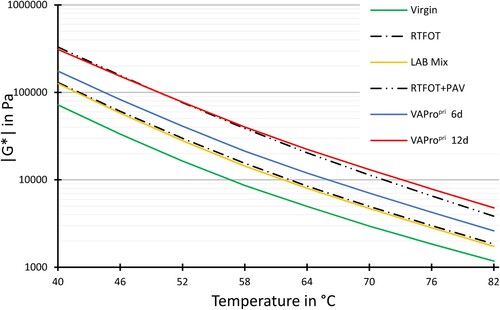
In a first step, it was necessary to find appropriate ageing parameters to reach a long-term aged state. Compared to VAProcyl, VAPropri contains roughly five times more material. This fact requires altering the parameters used for VAProcyl. It was decided to keep the pressure, the flow rate and the temperature at the standard values of 0.5 bar, 1 l/min and +60°C, respectively. Therefore, only the duration of conditioning in VAPropri was changed. After ageing, the binder was recovered, tested by DSR and compared to RTFOT- and PAV-aged binders. The mixture that was conditioned with the VAPropri prototype is a SMA11 with binder A. From this mixture, slabs with the dimensions of 320 × 260 × 70 mm were produced. The air void content of these slabs is between 8% and 9%-V.
The duration was doubled from 3 to 6 days in the first cycle. Figures and illustrate the dynamic modulus |G*| and phase angle δ of the recovered and the reference bitumen samples. Here you can see, the 6 days ageing does not reach the RTFOT + PAV binders in terms of increasing shear modulus |G*|. The decrease of phase angle δ is comparable to RTFOT + PAV.
Figure 10. DSR results: SMA11 (binder A) – Comparison of phase angle δ of the recovered and reference binders.
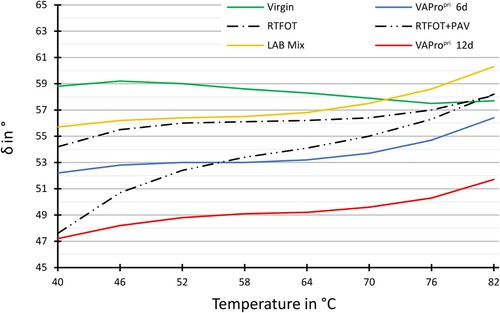
Based on these DSR measurements, the duration was raised to 12 days: Analysing these results, 12 days of VAPropri ageing leads to the binder being in an LTA state. The increase of dynamic modulus |G*| corresponds to RTFOT + PAV-aged binders. The decrease of phase angle δ is even higher compared to the reference ageing.
Results and discussion of the main experimental part
Resulting from the VAPropri pre-study, a first TSRST test program with the new ageing cell was conducted using a duration of 12 days. For analysis, the following parameters derived from the temperature–stress curve were investigated:
Temperature at failure Tcrack
Stress at failure σcrack
Transition point from visco-elastic to elastic behaviour Tt
Slope of the stress curve at +5°C k5
Length of the linear part of the temperature–stress relation Llin
The transition point Tt characterises the transition from visco-elastic (stress relaxing) to elastic (brittle) material behaviour. A common approach found in literature is to simply take the temperature at 50% of σcrack (Tapsoba et al., Citation2016). For this paper, a more analytical approach was pursued. To find the transition point between dominating visco-elastic and elastic, a linear regression is aligned to the linear part of the cooling curve from the point of failure backwards. Once the result curve differs significantly from the linear regression, the point Tt is reached. To find this point, a step-wise approach is taken. A linear is defined by two points: The starting point is fixed to Tcrack (point n); and the end point is the data point next to Tcrack (point n − 1) in the first step. Subsequently, the end point is shifted along the curve (point n − 2, n − 3, …). For every step, a linear regression and its coefficient of determination R2 are calculated. For the first step, which consists of the first two data points, R2 is obviously 1.0. Moving on, the coefficient of determination starts dropping. If the curve can no longer be considered linear, R2 drops steeply. To satisfy the linearity, an R2 limit at 0.9999 was set as a termination point for the stepwise approach.
The lab test program consists of three STA specimens and two 12-day VAPropri-aged specimens. These specimens were made from SMA11 using binder A. Figure shows the results of these tests. For comparison and to show the proof of principle, field-aged specimens were also tested. These field samples are from an AC11 using binder A (field A) and binder B (field B). For every level of ageing (STA and LTA), three specimens are tested. The results are shown in Figures and . The diagrams show the evolution of tensile stresses due to cooling (cryogenic stresses) over temperature. For each set of samples, the mean value as well as the standard deviation are shown. Tcrack as well as Tt are given in the diagrams for each mix. Table summarises all parameters that were analysed.
Table 3. Results of the TSRST analysis.
By looking at the resulting cooling curves, the difference in low-temperature performance between a straight-run unmodified binder (Figure ) and a polymer-modified binder (Figure ) can be clearly observed for the field-aged samples with same mix design: The unmodified binder reaches a lower Tcrack as well as a lower σcrack but builds up stresses more quickly (for example, see stress at −10°C and −15°C).
For the comparison of the lab-aged (VAPropri) and field-aged binders, comparing the absolute values of results seems not to be useful. The samples differ in their mix designs: It is more purposeful to do a relative comparison, investigating if the VAPropri-aged samples have a similar evolution in parameters due to lab ageing compared to field samples.
Analysing the point of failure, it can be observed that Tcrack of the VAPropri-aged specimens decreases by 1.2°C, field A decreases by 2.4°C and field B decreases by 1.1°C. It becomes obvious that Tcrack is affected by field and lab ageing only to a minor degree. Observed changes in lab and field ageing show the same trend but are not significant. It seems that this parameter is not well-suited to track changes in material behaviour due to ageing. The change of the tensile stress at the point of failure (σcrack) is also not conclusive: For VAPropri and field B, it increases by 7%. Field A shows a decrease of about 8%.
When investigating the transition in material behaviour Tt, it can be seen that this point occurs earlier for the aged material. This shows that the aged material has less stress–relaxation capability. Tt decreases by 3.0°C for VAPropri, 3.7°C for field A and 3.8°C for field B. These differences stand for the significant reduction of the stress relaxation capability of the aged material.
As described by Isacsson and Zeng (Citation1998), the relationship between Tcrack and Tt shows a linear correlation regardless of the different mix designs and ageing states. This is illustrated in Figure .
Regarding further parameters, which are listed in Table , the following trends can be observed.
The slope of the curve at +5°C (k5) describes the stress evolution in a region of visco-elastic material behaviour. For lab, as well as for field ageing, this indicator strongly increases due to ageing by the factor of 2.1 to 3.7. Again, the changes of VAPropri and field-aged samples are comparable.
The length of the linear part of the stress curve (between Tcrack and Tt) is another interesting parameter when investigating the changes due to ageing at low temperatures: For all samples, the length of this part is roughly doubled when comparing STA and LTA. This shows that the more elastic or brittle behaviour does not only occur earlier (Tt), the linear range is also prolonged, indicating a higher strength of the aged material.
In summary, we can say that the cracking temperature Tcrack and the respective cracking stress σcrack do not appear to be the adequate parameters to compare aged and unaged low-temperature behaviour. The transition temperature Tt, the slope of the curve at +5°C k5 and length of the linear part of the stress curve Llin look like more suited parameters for this task.
The comparison of these results shows the proof of principle of the new VAPropri prototype for obtaining prismatic specimens. The 12-day VAPropri-aged specimens lead to similar results and same trends in TSRST compared to 60-month field aged samples.
Summary and outlook
This presented study sums up several adaptions of the VAProcyl set-up and the development of a new ageing cell (VAPropri), which is capable of ageing a complete asphalt mix slab. This design opens up the possibility to obtain shapes of various specimens instead of being limited to one specific size. Ageing parameters were calibrated to achieve a |G*| of the binder comparable to PAV + RTFOT-aged samples.
The proof of principle has been demonstrated by comparing TSRST results of VAPropri-aged and field-aged samples. Results show faster increase in tensile stress during cooling, earlier occurrence of the transition from visco-elastic to elastic behaviour and an elongation of the linear part of the stress curve compared to unaged samples. This indicates that the material has less stress relaxation capability after ageing. Tcrack and σcrack are hardly affected by the ageing process (lab and field), but a linear correlation can be found for these two parameters.
The next steps include the optimising functionality of the new cell and further calibration of the ageing parameters like gas flow and ageing duration. Once the prototype has been improved, a study with a larger number of samples is planned to provide a more detailed statistical analysis.
VAPro enables conditioning compacted asphalt specimens in the lab with realistic (i.e. close to field) ageing conditions. This provides the possibility to assess the long-term behaviour of asphalt mixtures for mix design and optimisation with regard to realistic ageing mechanisms.
Acknowledgement
The main author greatly appreciates the skilful help of all lab technicians and the possibility to use the laboratory infrastructure.
Disclosure statement
No potential conflict of interest was reported by the author(s).
Additional information
Funding
References
- Atkinson, R. (1990). Gas-phase tropospheric chemistry of organic compounds: A review. Atmospheric Environment. Part A. General Topics, 24(1), 1–41. https://doi.org/https://doi.org/10.1016/0960-1686(90)90438-S
- Baek, C., Underwood, B. S., & Kim, Y. R. (2012). Effects of oxidative aging on asphalt mixture properties. Transportation Research Record, 2296(1), 77–85. https://doi.org/https://doi.org/10.3141/2296-08
- CEN. (2009). EN 12591: Bitumen and bituminous binders – Specifications for paving grade bitumens.
- CEN. (2012a). EN 12697-24: Bituminous mixtures – Test methods for hot mix asphalt – Part 24: Resistance to fatigue.
- CEN. (2012b). EN 12697-46: Bituminous mixtures – Test methods for hot mix asphalt – Part 46: Low temperature cracking and properties by uniaxial tension tests.
- CEN. (2012c). EN 14769: Bitumen and bituminous binders – Accelerated long-term ageing conditioning by a pressure ageing vessel (PAV).
- CEN. (2012d). EN 14770: Bitumen and bituminous binders – Determination of complex shear modulus and phase angle – Dynamic shear rheometer (DSR) (Vol. EN 14770). European Committee for Standardization.
- CEN. (2013a). EN 12697-3: Bituminous mixtures – Test methods for hot mix asphalt – Part 3: Bitumen recovery: Rotary evaporator.
- CEN. (2013b). EN 14023: Bitumen and bituminous binders – Specification framework for polymer modified bitumens.
- CEN. (2015). EN 12607-1: Bitumen and bituminous binders – Determination of the resistance to hardening under influence of heat and air – Part 1: RTFOT method.
- CEN. (2016a). EN 12697-35: Bituminous mixtures – Test methods for hot mix asphalt – Part 35: Laboratory mixing.
- CEN. (2016b). EN 13108-1: Bituminous mixtures – Material specifications – Part 1: Asphalt concrete.
- CEN. (2016c). EN 13108-5: Bituminous mixtures – Material specifications – Part 5: Stone mastic asphalt.
- da Costa, M. S., Farcas, F., Santos, L., Eusebio, M. I., & Diogo, A. C. (2010). Chemical and thermal characterization of road bitumen ageing. Advanced Materials Forum V, Pt 1 and 2, 636-637, 273–279. https://doi.org/https://doi.org/10.4028/www.scientific.net/MSF.636-637.273
- Frigio, F., Raschia, S., Steiner, D., Hofko, B., & Canestrari, F. (2016). Aging effects on recycled WMA porous asphalt mixtures. Construction and Building Materials, 123, 712–718. https://doi.org/https://doi.org/10.1016/j.conbuildmat.2016.07.063
- Hagos, E. T., Molenaar, A. A. A., & van de Ven, M. F. C. (2009). Chemical characterization of laboratory and field bitumen aging in porous asphalt concrete. In A. Loizos, M. N. Partl, T. Scarpas, & I. L. Al-Qadi (Eds.), Advanced testing and characterisation of bituminous materials (Vols. 1 and 2, pp. 173–184). CRC Press.
- Hofko, B., Handle, F., Eberhardsteiner, L., Hospodka, M., Blab, R., Fussl, J., & Grothe, H. (2015). Alternative approach toward the aging of asphalt binder. Transportation Research Record, 2505(1), 24–31. https://doi.org/https://doi.org/10.3141/2505-04
- Hofko, B., Hospodka, M., Blab, R., Eberhardsteiner, L., Fussl, J., Grothe, H., & Handle, F. (2014). Impact of field ageing on low-temperature performance of binder and hot mix asphalt. In R. Y. Kim (Ed.), Asphalt pavements (Vols. 1 and 2, pp. 381–395). CRC Press.
- Hofko, B., Maschauer, D., Steiner, D., Mirwald, J., & Grothe, H. (2020). Bitumen ageing – Impact of reactive oxygen species. Case Studies in Construction Materials, 13, e00390. https://doi.org/https://doi.org/10.1016/j.cscm.2020.e00390
- Isacsson, U., & Zeng, H. (1998). Low-temperature cracking of polymer-modified asphalt. Materials and Structures, 31(205), 58–63. https://doi.org/https://doi.org/10.1007/Bf02486415
- Jing, R., Varveri, A., Liu, X., Scarpas, A., & Erkens, S. (2019). Laboratory and field aging effect on bitumen chemistry and rheology in porous asphalt mixture. Transportation Research Record: Journal of the Transportation Research Board, 2673(3), 365–374. https://doi.org/https://doi.org/10.1177/0361198119833362
- Kley, D. (1997). Tropospheric chemistry and transport. Science, 276(5315), 1043. https://doi.org/https://doi.org/10.1126/science.276.5315.1043
- Lin, P., Huang, W., Li, Y., Tang, N., & Xiao, F. (2017). Investigation of influence factors on low temperature properties of SBS modified asphalt. Construction and Building Materials, 154, 609–622. https://doi.org/https://doi.org/10.1016/j.conbuildmat.2017.06.118
- Lu, X., & Isacsson, U. (1998). Chemical and rheological evaluation of ageing properties of SBS polymer modified bitumens. Fuel, 77(9), 961–972. https://doi.org/https://doi.org/10.1016/S0016-2361(97)00283-4
- Morian, N., Hajj, E. Y., Glover, C. J., & Sebaaly, P. E. (2011). Oxidative aging of asphalt binders in hot-mix asphalt mixtures. Transportation Research Record: Journal of the Transportation Research Board, 2207(-1), 107–116. https://doi.org/https://doi.org/10.3141/2207-14
- Petersen, J. C. (2009). A review of the fundamentals of asphalt oxidation chemical, physicochemical, physical property, and durability relationships (TRB Transportation Research Circular E-C140). http://onlinepubs.trb.org/onlinepubs/circulars/ec140.pdf
- Seinfeld, J. H., & Pandis, S. N. (2016). Atmospheric chemistry and physics: From air pollution to climate change (3rd ed.). Wiley.
- Steiner, D., Hofko, B., & Blab, R. (2016). Effect of air void content and repeated testing on stiffness of asphalt mix specimen. Civil Engineering Conference in the Asian Region CECAR 7, Waikiki, USA.
- Steiner, D., Hofko, B., Grothe, H., & Blab, R. (2018). Impact of conditioning temperature on thermal and oxidative aging. ISAP 2018, Fortaleza Brazil.
- Steiner, D., Hofko, B., Hospodka, M., Handle, F., Grothe, H., Fussl, J., Eberhardsteiner, L., & Blab, R. (2016). Towards an optimised lab procedure for long-term oxidative ageing of asphalt mix specimen. International Journal of Pavement Engineering, 17(6), 471–477. https://doi.org/https://doi.org/10.1080/10298436.2014.993204
- Tapsoba, N., Baaj, H., Sauzéat, C., Di Benedetto, H., & Ech, M. (2016). 3D analysis and modelling of thermal stress restrained specimen test (TSRST) on asphalt mixes with RAP and roofing shingles. Construction and Building Materials, 120, 393–402. https://doi.org/https://doi.org/10.1016/j.conbuildmat.2016.05.092
- Wei, H., Bai, X., Qian, G., Wang, F., Li, Z., Jin, J., & Zhang, Y. (2019). Aging mechanism and properties of SBS modified bitumen under complex environmental conditions. Materials, 12(7). https://doi.org/https://doi.org/10.3390/ma12071189
- Yiqiu, T., Lei, Z., & Lun, J. (2012). Analysis of the evaluation indices from TSRST. Journal of Materials in Civil Engineering, 24(10), 1310–1316. https://doi.org/https://doi.org/10.1061/(ASCE)MT.1943-5533.0000509

